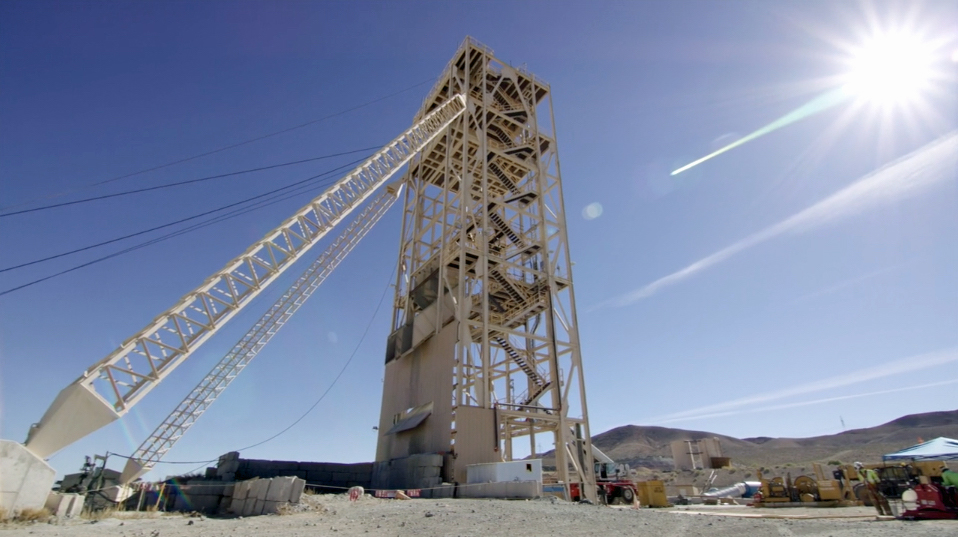Nevada Copper building first US copper mine in a decade
Pumpkin Hollow goes into production next year, but the underground mine is only the first phase of a planned Nevada copper operation four times the size

Sun shines on Pumpkin Hollow underground project set for production in a year.
For Yerington it’s been 40 years in the making.
The waste dumps left behind by Anaconda after shutting copper operations in 1978 still loom large over the small town in Nevada’s Mason Valley, not far from Lake Tahoe and California state lines.
There have been a few false dawns and dashed hopes of a revival during the interceding decades in this region of the Silver State where mining dates back to the late 1800s.
But next year the town of little over 3,000 souls – who are proud of the fact that it’s the only place in the world called Yerington – will see the opening of a new mine which within short five years could eclipse the heydays in both size and scope.
If this was 2011, Pumpkin Hollow may well have been a magnetite mine
Nevada Copper’s Pumpkin Hollow project sits 13km down a road lined by farms (row upon row of irrigated onions planted with what looks like down-to-the-centimetre precision) which sustained Lyon County during the lean years.
The deposit was first discovered by US Steel in 1960 and if this was 2011, Pumpkin Hollow may well have been a magnetite mine.
Toronto-listed Nevada Copper acquired the property in 2005 and after extensive study and drilling in the ensuing years came close, but never quite made the decision to build a mine, to the chagrin of the locals.
So what’s different this time around?
The copper price is trading today where it was in 2006 after all. And even seasoned industry watchers were unnerved by the metal’s precipitous drop this summer.
But Nevada Copper is a different entity and Pumpkin Hollow is in a new jurisdiction.
All aboard

Yerington is gearing up for influx of jobs and revenue
Nevada Copper has undergone a rapid transformation following a $380m recapitalization at the end of last year led by Pala Investments, the firm behind another recent high-profile reboot – Cobalt 27.
Other big mining finance names including JP Morgan, BlackRock, Capital Group, CIBC and Red Kite are also investors.
Nevada Copper has undergone a rapid transformation following a $380m recapitalization at the end of last year
In April, President and CEO Matt Gili was recruited from Barrick Gold to join Nevada Copper’s board. Gili was in charge of the gold giant’s Cortez complex in Nevada.
Gili joins other industry heavyweights including Chairman Stephen Gill from Pala, Tom Albanese, former Rio Tinto CEO, Capital Group’s Ernie Nutter and Raffaele Genovese, ex-Glencore, who all came on board in the past year.
It’s not difficult to see what attracted Gili to Nevada Copper. Opportunities to build and operate major new mines in the US are hard to come by.
The last new copper mine in the country to go into into production – Freeport’s Safford mine in Arizona – was over a decade ago. As for Nevada, you have to go back to 2004 when Poland’s KGHM restarted the historic Robinson mine.
Renovation
“The number one success factor for a new mine is the involvement of executives and management on site. You don’t build a mine within budget and on time from a remote corporate head office,” Gili tells MINING.com.
Before Barrick, Gili served as COO of Rio Tinto’s Oyu Tolgoi mine in Mongolia which is set to become the world’s third largest copper mine.
You only have to listen to him recounting his years in Mongolia and the long drives across the desert and the many feasts of boiled mutton and camel’s milk he enjoyed to know that Gili is a hands-on guy.
Not that Nevada is nearly as unforgiving as the Gobi Desert. And in a labour market in the US which is the tightest in generations that’s important.
Reno is little more than an hour’s drive from Pumpkin Hollow and is fast shaking its reputation as Las Vegas’s poor cousin thanks to an influx of tech workers escaping Silicon Valley’s cost of living and a massive new industrial hub anchored by carmaker Tesla’s so-called gigafactory.

President and CEO Matt Gili joined Nevada Copper in April
Cut red tape, not corners
A recovering copper price helps, but it was a unique agreement with the local community that laid much of the groundwork for Pumpkin Hollow.
The mine is being built on private land. In 2015 after a four-year process, just over 10,000 acres of Federal Land was transferred to the City of Yerington and subsequently sold to Nevada Copper.
That enabled the company to operate under the auspices of the Nevada Division of Minerals, speeding up the permitting process and at the same time giving Yerington direct benefits under the state’s profit share scheme.
The innovative arrangement was the brainchild of Nevada Copper’s VP for environment and external relations Timothy Dyhr and Yerington’s city managers.
“With EPCs the upfront negotiations are brutal, but after you shake hands, you execute together.”
Dyhr, who’s worked all over the world including as BHP’s environment chief for copper, says approvals and permit decisions that would take six months plus making its way through the federal system now takes weeks.
“The project still adheres to all environmental regulations – we’re cutting red tape, not corners,” Dyhr tells MINING.com.
Price fixing
Another innovation Gili is bringing to construction of Pumpkin Hollow is the use of EPC (Engineering, Procurement and Construction) contracts.
With EPC agreements the contractor is responsible for final completion of a project at a fixed cost and is used extensively in Africa, Australia and other parts of the mining world. With investor concern over budget blowouts and delays growing, it is gaining traction in the Americas.
“With EPCs the upfront negotiations are brutal, but after you shake hands, you execute together,” Gili says adding that with more traditional contracts (EPCM) where the construction phase is managed together; the opposite is true: “ Negotiation is the easy part, and the fighting is during execution.”
“From my experience it’s not material or labour costs that make projects go over budget, it’s delays. With EPCs everything is worked out beforehand. It’s a good thing for the industry, it forces discipline.”
Underground start
Following a $70m streaming deal for gold and silver from the deposit with financiers Triple Flag and a second public offering the project is fuelled to the finish for a capital outlay of $197m.
That’s a miserly sum for a 5,000 tonnes-per-day underground mine that will produce 60m pounds of copper (~27,000 tonnes) per year during the first five years of operations, as well as 9,000 ounces of gold and 173,000 ounces of silver.
The board gave the green light for the start of full-scale construction at the end of August and all indications are that Nevada Copper will make its target to start production in the fourth quarter 2019. Nevada Copper has contracted Sedgman and Cementation for the project and the 40 workers currently on site will grow to 150 in coming months. The underground mine will eventually have a workforce of around 300.

Aerial view of Pumpkin Hollow underground project near Yerington, NV.
Phase one of the underground mine has a 13½ year mine life and will be a nice cash generator – $80m per year average says Nevada Copper – and there is scope for expansion underground, but the company has much more ambitious plans for Pumpkin Hollow.
Phase this
During MINING.com’s visit, the company released a preliminary economic assessment for an open pit on the property.
A 37,000t per day operation with a price tag of $592m would be expanded eight years later to 70,000t for $447m. Over the 20 year life production is pegged at 167m pounds (~75,000t) per year and net sales revenues at over $10 billion.
Together with the underground mine, it would rank Pumpkin Hollow at number three in the US, behind only Morenci and Bingham Canyon in terms of production, given that the proposed Rosemont and Resolution mines in Arizona remain stuck in permitting.
In the district, where firms including Quaterra, Mason Resources and others are advancing projects, resources of more than 33 billion pounds copper have been identified. That’s ore Nevada Copper could feed its processor.
Gili says construction could start in 2020 or earlier and completed two years later and the company “is committed not to return to equity markets.” One third of the open pit capital outlay would come from cash flows from the underground, another from a streaming deal and the final $200m through debt.
The open pit has always been on the drawing board, but a new phased approach to development shifts the focus to “project value and economic returns, rather than chasing scale.”
This strategy vastly increases the chances of the open pit complex being built. And 650 new direct jobs created.
And for Yerington that must be priority number one.
(Pumpkin Hollow travel and accommodation were provided by Nevada Copper)
More News
Nornickel believes 2026 will bring dividends, CEO says
Nornickel did not pay full-year dividends for 2022, 2023 and 2024.
December 27, 2025 | 07:42 am
{{ commodity.name }}
{{ post.title }}
{{ post.date }}




6 Comments
Personix Generix
Way to go!
This is what’s called DOING and not WHINING.
jameister
my hat is off to the team that got through the permitting process…..congratulations and expectations for your continued success!!
Mike Failla
Excellent. Now we need to review and streamline the permitting. 10 years is to long. Sure some has been done but more needs to be done to this archaic and cumbersome system. Just sayin….
wags1
I suppose I could do the math myself, but articles like this that don’t mention grade sort of irk me a little.
Joel
What about Florence Copper, Rosemont Excelsior and the behemoth Rio Tinto/BHP Resolution mines? They’re all “new” and either permitted or far ahead in the process? Not sure how this is the first since Safford?
MINING.com Editors
Hi Joel, thanks for the comment. Nevada Copper would be the first since Safford since Florence Copper is only building a production test facility and as I mention in the piece both Rosemont and Resolution are still in the permitting process so may not be built. – Frik